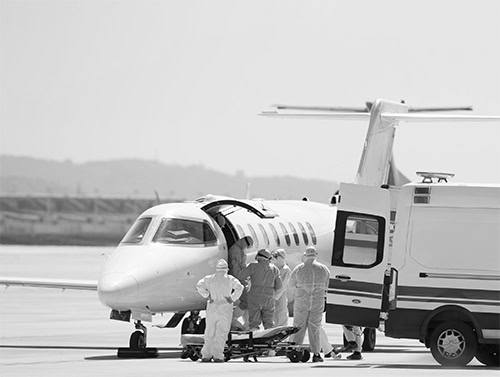A Complex Fracture Transfer - Flying to Safety with Precision and Compassion
In the world of air ambulance services, every mission carries unique challenges that test our expertise and dedication. Recently, we undertook a mission that required both technical skill and unwavering commitment to patient care.
Our journey began with an elderly gentleman who had suffered a severe fall, resulting in a complex comminuted fracture of the acetabulum and ramus of the ischium. His family wished for him to undergo surgical fixation at an overseas facility, necessitating an air ambulance transfer.
The mission was fraught with challenges. Due to the nature of his fractures, a traction device was recommended, but his caregivers denied consent. We could only use skin traction for a period not exceeding eight hours, while the travel time would surpass this limit. This posed significant challenges in managing his movements, preventing displacement of the fracture segments, and controlling his pain.
The situation became more complex when the patient experienced shortness of breath and chest pain upon admission. He was screened for a pulmonary embolism, which came back negative. However, elevated cardiac enzymes indicated a need for immediate cardiac attention. After initial stabilization, the cardiology team cleared him for travel with strict cardiac monitoring requirements.
Success hinged on meticulous preparation and collaboration. Extensive discussions took place among our aeromedical team, the cardiac team, the orthopedic team, and intensivists. We weighed the risks and benefits, establishing a comprehensive plan prioritizing strict immobilization, extreme caution during movement, adequate pain control, continuous cardiac monitoring, and minimizing exertion.
From the moment our aeromedical team arrived, every step was executed with precision. A specialized transport mattress and scoop stretcher ensured minimal movement and immobilization of fracture segments during the transfer. Pain control was managed with a pre-planned analgesia regimen, and cardiac status was continuously monitored. DVT prophylaxis was also maintained.
Throughout the flight, our team provided continuous reassurance to the patient and his family, detailing our plan and safety measures. The result was a successful, pain-free, and cardiac-stable transfer of a non operated fracture patient, avoiding complications and minimizing risks.
This mission stands as a testament to the power of teamwork, meticulous planning, and unwavering dedication to patient care. Our aeromedical team once again demonstrated that with the right expertise and commitment, we can overcome even the most challenging situations to deliver exceptional care.



